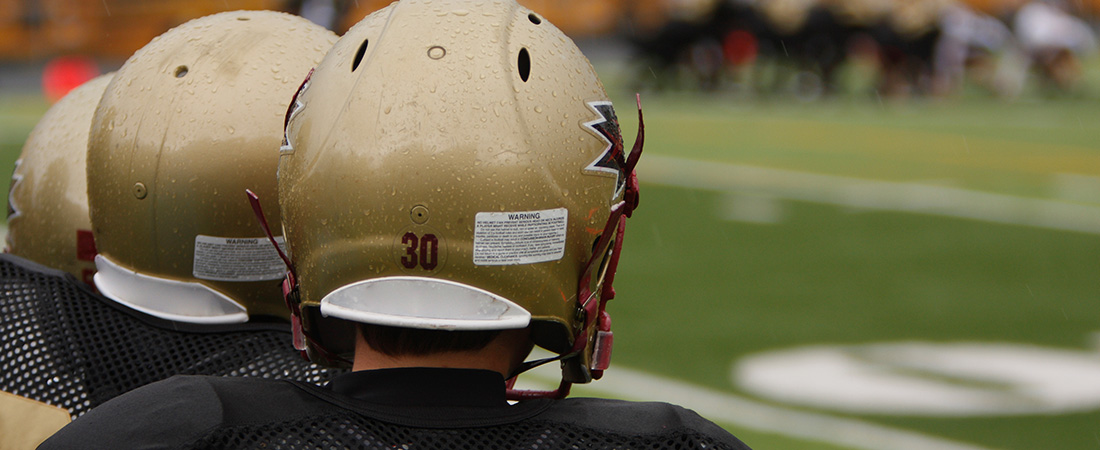Head Games

Concussions are classified as a mild form of traumatic brain injury (TBI). [CSN]
Studies have shown that girls now experience a higher rate of sport-related concussions than boys. [CSN]
Each year, U.S. emergency departments (EDs) treat an estimated 173,285 sports- and recreation-related TBIs, including concussions, among children and adolescents, from birth to 19 years.* [CDC]
During the last decade, ED visits for sports- and recreation-related TBIs, including concussions, among children and adolescents increased by 60%.* [CDC]
Sources:
Children’s Safety Network: Sport-Related Concussions in Children and Adolescents Fact Sheets
Centers for Disease Control and Prevention: Concussion in Sports and Play
*Gilchrist, J., Thomas, K. E., Xu, L., McGuire, L. C., & Coronado, V. G. (2011). Nonfatal sports and recreation related traumatic brain injuries among children and adolescents treated in emergency departments in the United States, 2001–2009. Morbidity and Mortality Weekly Report, 60(39), 1337–1342.
Concussions have long been an “invisible” injury in contact sports. Soccer, football, and hockey players may complain about seeing stars after a big hit, but absent any visible cuts or bruises, they often brush themselves off and go right back into the game.
But new research is revealing that concussions are not just temporary impairments. They are significant injuries that can have long-term consequences, especially in children whose brains are still developing.
An assistant director of EDC’s Children’s Safety Network (CSN), Jennifer Allison has studied the risks of, and state-level responses to, concussions in youth sports. CSN has recently published a series of fact sheets on the topic for public health professionals, parents, and coaches. Allison hopes to promote awareness about this difficult injury, helping to make concussion prevention and treatment more visible.
Q: What are the tell-tale signs that a child has suffered concussion?
 Allison: Children who have suffered a concussion can experience a variety of symptoms, including headaches, nausea, and difficulty sleeping. Sometimes a child may lose consciousness, but not always. A concussion may still be present even if the child never lost consciousness.
Allison: Children who have suffered a concussion can experience a variety of symptoms, including headaches, nausea, and difficulty sleeping. Sometimes a child may lose consciousness, but not always. A concussion may still be present even if the child never lost consciousness.
Q: Are concussions more worrisome in the early years?
Allison: There used to be an assumption that children would recover more quickly from concussions than adults, but more and more research is showing that concussions are serious injuries that can have long-term repercussions.
What we are finding is that it actually takes children longer to recover. While most children will fully recover in 7 to 10 days, some children will take longer to heal and will experience more serious symptoms. We are also learning that children who sustain one concussion are at increased risk for sustaining future concussions; the initial injury seems to make the brain more vulnerable.
Q: Can a concussion affect a child’s ability to learn?
Allison: One of the most compelling findings from research is that a concussion can actually affect a child’s classroom performance. Students with concussions may struggle to read and have problems focusing, and their cognitive abilities can be temporarily impaired. In some cases, students who were experiencing behavioral problems at school were found to be suffering from undiagnosed concussions.
Q: Is preventing concussions as simple as wearing protective headgear when playing sports?
Allison: Not exactly. Helmets do protect players from skull fractures, but they do not necessarily protect against concussions in contact sports like football. Helmets cannot prevent the brain from moving within the skull upon violent impact—this is what causes concussions. So while it’s certainly important for children to wear protective equipment in sports, concussions can still occur even when all safety precautions are followed.
Q: How can teams minimize concussions—and treat them appropriately when they do happen?
Allison: If it is suspected that a child has sustained a concussion, he or she should be removed from play immediately. That child should only return to athletics after being evaluated and medically cleared by a health care provider who has experience diagnosing and treating concussions.
Players have an important role, too. They need to understand that player safety begins with following the rules of the game. They also need to know what a concussion is, and why these injuries can be so severe. Hopefully, this knowledge will lead them to take more care in terms of protecting themselves when they’re actually on the playing field.